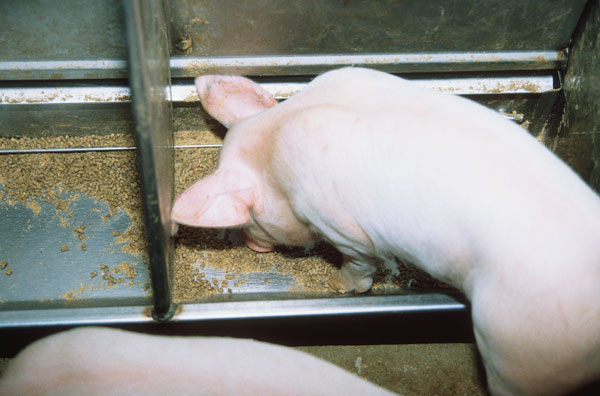Making sure equipment is properly maintained is just one example of the ways the person working in the barn can impact feed efficiency. Mike Tokach, Kansas State University (KSU), says focusing on specific tasks prior to loading a barn with new pigs, during the loading phase, while doing daily chores, and again when the barn is unloaded can have a positive influence on feed efficiency.

Wasting the equivalent of a feeder’s worth of feed by running it into a manure pit can definitely have a negative impact on feed efficiency.
Making sure equipment is properly maintained is just one example of the ways the person working in the barn can impact feed efficiency. Mike Tokach, Kansas State University (KSU), says focusing on specific tasks prior to loading a barn with new pigs, during the loading phase, while doing daily chores, and again when the barn is unloaded can have a positive influence on feed efficiency.
Prior to Entry
A clean barn includes clean feeders. Before a new group of pigs enters a barn, the feed bins should be emptied to ensure pigs can start on appropriate diets. “A late finishing diet has a 40% lower lysine level than a grower diet. Obviously, feed efficiency is not going to be very good if you start pigs out on a diet that is 40% below their lysine requirement,” Tokach says.
In addition to thoroughly cleaning the facility, check and repair feed handling equipment. Look for leaking bins, broken feed lines and inoperable feeder adjustment rods. Grease the bearings on equipment between groups and take care of any previous “temporary” fixes.
“Duct tape is a short-term repair. If you don’t take the time to make the permanent repair before the next group of pigs enters the barn, you could end up with a disaster,” Tokach says. In addition, check fans, fan covers and louvers, sprinklers, heaters, curtains, insulation and waterers as part of the regular maintenance schedule between groups.
Loading the Barn
While loading the new group into the barn, do not sort pigs into tight weight categories. “Studies show a negative effect on growth performance when sorting pigs into light, medium and heavy categories because the pigs fight more compared to pigs that have not been sorted by weight range,” he explains. Care should be taken to not overstock pens or leave too many open pens. Some feeders may not work well if pigs are not placed on both sides of a fenceline feeder.
Daily Chores
Attention to detail while doing daily chores can help improve feed efficiency. Making sure pigs are healthy, implementing euthanasia plans in a timely manner and making sure pigs have water available at all times are important steps.
Tokach encourages barn managers and growers to follow correct feed budgets and take note of amino acid levels, proper energy levels and how fiber content and withdrawal of distiller’s dried grains with solubles (DDGS) can influence feed efficiency on a carcass basis. Tools are available from many feed companies to help manage feed budgets. A feed budget calculator is also available online at www.KSUswine.org.
Managing the pigs’ environment means maintaining air quality and minimizing heat stress and cold temperatures. “Studies have shown a negative impact on feed efficiency from going above or below a pig’s critical temperature,” Tokach says. “Undergoing heat stress takes energy and results in poor feed efficiency, too. It goes back to barn maintenance. Make sure the fans and sprinkler systems are all working properly before hot weather and high critical temperatures become a problem.”
Feeder Adjustment
Proper feeder adjustment plays a crucial role in feed efficiency. Tokach recommends 50% pan coverage for most dry feeders now instead of previous recommendations for 15-25% pan coverage. He says if there is adequate to excess feeder space, opening feeders too much can increase feed disappearance and result in poorer feed efficiency, particularly after approximately 150 lb. However, if pigs are restricted on feeder space, opening feeders will increase average daily feed intake and average daily gain.
Touching on feeder design, Tokach generally recommends that feeders be at least 14 in. wide, or the shoulder width of a pig right before market, and approximately 10 in. deep. “It is important that the pig is able to eat freely without rubbing its head on the storage compartment of the feeder while eating,” he says.
While feeder dividers can make it more difficult to adjust feeders, they do allow more pigs to eat at one time because pigs are forced to stand perpendicular to the feeder.
Unloading the Barn
Unloading the barn is yet another area where a barn manager can have a tremendous impact on feed efficiency. Tokach says savings can be made by withdrawing feed 12 to 18 hours prior to pigs being processed at the slaughter plant. “You don’t ever want the pigs off feed for more than 24 hours before processing. Time in transit and holding at the plant should be included in the calculation of time off feed,”
he says.
Tokach also recommends pulling some pigs from all pens when marketing. “Research shows topping off the barn improves growth rate of all remaining pigs in the pen. By pulling 16% of pigs from the pen, substantial feed savings of 13 lb./pig were realized while producing the same total market weight in one research trial,” he relates.
Remember to handle pigs with care at every step in the production process. Each 0.5% increase in mortality increases closeout feed efficiency by 0.02 because less weight will be marketed.
Lora Berg is a freelance writer from Lakeville, MN.
About the Author(s)
You May Also Like



